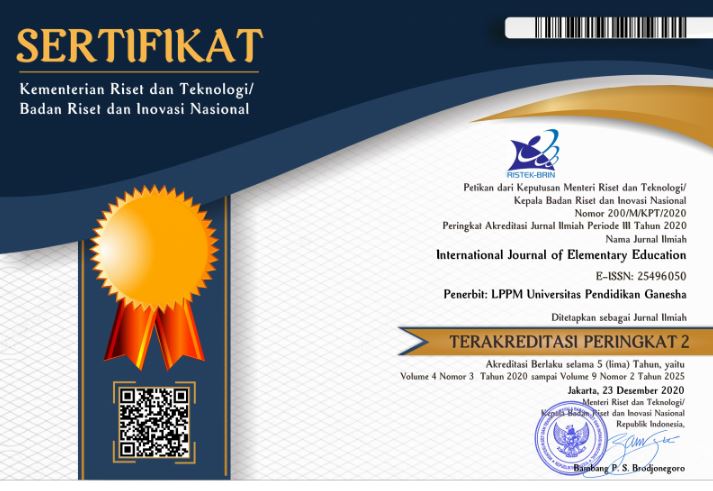Oral Language Abuse In Teaching-Learning Activity At Kabupaten Sumba Tengah Elementary School
DOI:
https://doi.org/10.23887/ijee.v2i4.16114Abstract
This research bacground based on student’s field experience of unsecure, oppressed, and fearful feelings caused by teacher’s utterances in class teaching learning activities. The objectives of this researh are: to identify the lingual form of lingulistic units inside teacher’s verbal violence/oral language abuse, to find teacher’s verbal violence/oral abuse expressions, and to identify factors causing verbal violence or verbal harassment or oral language abuse done by teachers in Kabupaten Sumba Tengah. The method used is descriptive qualitative method. The data gathering method/data gathering technique uses “Simak and Cakap Method” (Observing and Conversing Methods) and analyzed using “Agih and Padan Method”. The result of this study showed that verbal violence/verbal abuse are manifested in the lingual forms of linguistic units as words, phrases and sentences. The form of linguistic language tends to appear as exclamation sentences. Forms of verbal violences expressed by snaping, ignoring, uderestimating, humiliating in front of public/others, and doing accusations. Expressions tends to be manifested in the forms of accusations and humiliations toward children in front of others/public. The factors causing verbal abuse are education culture herritage of the past, teacher’s lack of knowledge on verbal abuse, teacher’s lack of vocubularies, their administrative tasks demands, discipling efforts, and local cultureReferences
Brennan, J. F. 2006. Sejarah dan Sistem Psikologi. Jakarta: PT. Raja Grafindo Persada.
Dardjowidjojo.2014. Psikolinguistik. Pengantar Pemahaman Bahasa Manusia. Jakarta: Yayasana Pustaka Obor Indonesia.
Fitriana Y, Pratiwi K, dan Susanto, A. V. 2015. Faktor-Faktor yang berhubungan dengan Perilaku Orang Tua dalam Melakukan Kekerasan Verbal Terhadap Anak Usia Pra-Sekolah. Jurnal Psikologi Undip. 14. No 1 : 81-93
Rionaldi, Artur. 2014. Tinjauan Yuridis Terhadap Kekerasan Yang Dilakukan Oknum Guru Terhadap Murid Di Sekolah.Jurnal fakultas hukum Universitas Admajaya Yogyakarta.
Surya, M. 2014. Psikologi Guru.Konsep dan Aplikasi. Bandung: Alfabeta
Sudaryanto. 1993. Metode dan Aneka Teknik Analisis Bahasa: Pengantar Penelitian Wahana Kebudayaan secara Linguistis. Yogyakarta: Duta Wacana University Press.
Sharpe, W. B. Glynn. 2011. Behind the Closed Door: Exploring Teacher Bullying and Abuse of Students, Characteristics of the Teache and Impact. A thesis of Doctor of Education.University of Toronto
Tower, Cynthia, C. 2002.Child Abuse and Neglect. USA: McGraw Hill.
Downloads
Published
How to Cite
Issue
Section
License
Authors who publish with the International Journal of Elementary Education agree to the following terms:
- Authors retain copyright and grant the journal the right of first publication with the work simultaneously licensed under a Creative Commons Attribution License (CC BY-SA 4.0) that allows others to share the work with an acknowledgment of the work's authorship and initial publication in this journal.
- Authors are able to enter into separate, additional contractual arrangements for the non-exclusive distribution of the journal's published version of the work (e.g., post it to an institutional repository or publish it in a book), with an acknowledgment of its initial publication in this journal.
- Authors are permitted and encouraged to post their work online (e.g., in institutional repositories or on their website) prior to and during the submission process, as it can lead to productive exchanges, as well as earlier and greater citation of published work. (See The Effect of Open Access)









